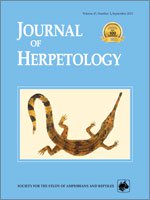A negative relationship between parasite intensity and male ornament condition or sexual display rate is one of the conditions of the parasite-mediated sexual selection model. In anurans, temporal properties of calling behavior, and particularly calling rates, are the best candidates to express a negative relationship with parasite intensity, given the high energy costs of calling and the fact that calls are potentially under strong intersexual selection. We studied the relationship between call parameters and helminth parasite intensity in males of a Brazilian subtropical treefrog, Hypsiboas prasinus. We tested the hypotheses that: 1) calling characteristics are correlated negatively to parasite intensity; and 2) the relationship between calling performance and parasite intensity is more pronounced when dynamic properties are considered. According to our predictions, only rate, the most important dynamic property of calling behavior, is associated with individual variation in parasite intensity. Males that call at higher rates show lower total parasite intensity. The negative relationship between parasite intensity and calling rate in H. prasinus could be because of the higher energy cycles associated with the maintenance of high calling performance. Also, theoretically, calling rate could work as an honest signal of anuran male quality, although the causal relationship between calling variation and parasite intensity, as well as the relevance of this relationship for female choice and male reproductive success, remain to be investigated.
How to translate text using browser tools
1 September 2013
Calling Behavior and Parasite Intensity in Treefrogs, Hypsiboas prasinus
Carla Bonetti Madelaire,
Reinaldo José da Silva,
Fernando Ribeiro Gomes
ACCESS THE FULL ARTICLE

Journal of Herpetology
Vol. 47 • No. 3
September 2013
Vol. 47 • No. 3
September 2013




